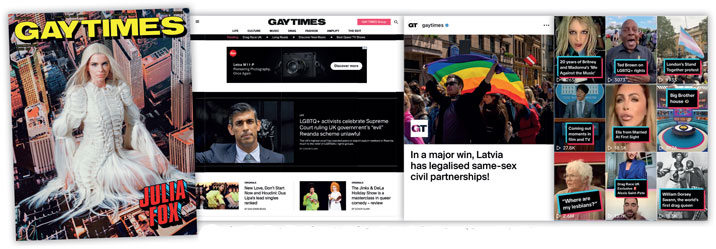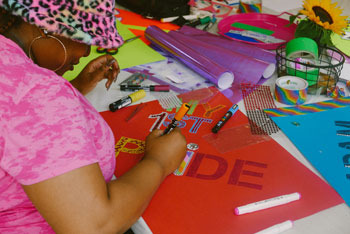
When Lewis Corner joined Gay Times as online editor in 2017, at the core of the brand was a print magazine attracting an audience made up mainly of cisgendered gay white men living in the northern hemisphere. Then, in 2019, he became editorial director of the magazine and introduced a forward-looking digital strategy which has attracted a huge global audience of LGBTQ+ readers balanced across both genders as well as those identifying as non-binary. By September 2021, the print magazine was no more, and the brand has never looked back.
In July, Lewis was named Editor of the Year (Consumer Media) at the 2023 PPA Awards. This was shortly followed by an announcement that he is moving to a new role at Gay Times as senior vice president, global content, a recognition of the brand’s successful move into new markets around the world.
Lewis says: “When I joined the company, obviously it had a digital and a social presence, but it was still a company very much circling a print magazine publication. That wasn’t at that point best representing the diverse experiences within our community. It was starting to feel a little dated in its approach.”
He set to work figuring out what a new digital strategy reaching out to younger, more diverse audiences, would look like. His previous role as music editor at Digital Spy enabled him to plug into the conversation around LGBTQ+ identities and experience through television, music, and other mediums. His arrival at Gay Times coincided with the success of shows such as ‘Years and Years’ about a family in a dystopian Manchester with a prominent gay story line, as well as the emergence of artists such as Sam Smith into the mainstream.
“While, historically, we’ve been directed more at gay and bi men, we wanted to better represent the full LGBTQ+ community and the different experiences that build up our community. That naturally led over time to increased growth because you’re speaking to a larger amount of people. We very quickly saw that we were capturing a much younger audience, particularly in social and digital. We saw a rebalancing of gender demographic within our audience,” he says.
Before the strategy kicked in, the audience was over 80% male, but the latest analytics show it is now 50/50 men and women. However, at the end of last year, the company wanted to dig deeper into these figures and found that 19% of readers identified as non-binary, 32% as male and 35% female, with the remainder other gender expressions. They have also seen an uplift in their audiences in the United States and Canada, as well as mainland Europe, South America and Africa.
The next part of the strategy is to continue to decentralise the London / UK centric brand and start working with teams and contributors around the world to better represent the LGBTQ+ community from a global perspective.
Lewis explains: “We’re always innovating to see how we can better represent people in different territories and avoid our content always coming through a global north, gay, white, cisgendered perspective. It was important for us to start diversifying our contributor pools so we can have more nuanced conversation that adds further context and understanding of those communities globally. I think we’ve led the way in that respect.”
He is particularly proud that their latest reader research shows 89% agreed Gay Times is a trustworthy brand, especially when it comes to its news reporting. He believes the world is “a scary place” for young LGBTQ+ people and feels they have a responsibility in what stories they choose to cover, how they cover them and who they give a voice to.
A pureplay approach
Each of the brand’s different platforms is treated as its own pureplay entity. The website is very much a place for long form content, pop culture reporting and building editorial campaigns.
“That’s where people come to better understand whether it’s certain issues or conversations in our community or what’s happening in the latest season of Drag Race,” he says.
Instagram works best as a breaking news format with bite size content addressing stories in the press. TikTok is a place for queer fandom – “a lot of music, Heartstopper, Red White and Royal Blue, that real fun content”.

Lewis is often asked what they are going to do for their Pride issue, to which he always answers ‘every issue is Pride issue for Gay Times’. Pride events take up at least four months a year around the globe and are a major focus for the magazine.
“A lot of our Pride coverage has worked well on TikTok. We send our social team to capture highlights from the day, to give a sense of what those Pride celebrations were about, capturing some of the placards, talking to the people marching. That’s resonated with younger audiences, particularly people who don’t have access to Pride events, whether they’re living outside of big cities, or in countries where Pride events don’t happen.”
It is also an opportunity for the brand to touch base with its audience in person at events or ‘activations’. Recognising that many of its younger readers are looking for events that don’t revolve around alcohol, at this year’s London Pride, Gay Times created a community space just off Regent Street for its ‘Pride Placard Pop-up Store’.
“It was open for three days and we invited people to come in and work with queer creatives on creating their own placards which they could then march with in the Pride celebrations,” Lewis explains.
The store created plenty of opportunities for content capture, and raised money for Micro Rainbow, a charity that supports LGBTQ+ asylum seekers.
“It brought a lot more purpose back into our Pride strategy and gave that sober creative space for people to connect with other members of the community. Our ambition is to roll that out more widely,” Lewis adds.
New commercial model
Having moved away from the print magazine, Gay Times has turned to a partnership model, helping brands to reach an LGBTQ+ audience in a responsible and effective way.
Lewis says: “When we started to increase engagement and audience, we switched to a partnership model, because we noticed that brands really want to speak to LGBTQ+ audiences, but they don’t always get it right. From a Gay Times perspective, we know that we can develop campaigns that better represent LGBTQ+ people; we also have the audience and the platforms to deliver that content.”
Campaigns include working with Apple Music to support emerging LGBTQ+ artists to break through to the mainstream. Some of those artists include names that are now huge, such as Arlo Parks. They have also worked with the likes of Google and Coca Cola.
“All these brands really want to make sure their brand campaigns are reaching LGBTQ+ people in a way that’s meaningful and impactful. When a big brand does an LGBTQ+ campaign and it goes wrong, that has a negative impact on the community whether they’re inadvertently pushing old stereotypes or not fully understanding the nuances of the queer experience. If we can work with brands to eliminate a lot of that risk, that only benefits the community,” says Lewis.
Going global
In his new role, he is tasked with establishing teams on the ground around the world, starting with a US office. Although this will be based in New York, he insists they want to speak to young LGBTQ+ people right across the United States and Canada.
“We have a real ambition to make sure it doesn’t just reflect a New York queer perspective. The US is such a huge country that there are very different challenges for LGBTQ+ people across the different states.”
He also wants to make sure there is a collaborative approach between international teams, rather than them feeling like siloed products.
There is a continued focus on social media, as, although they are enjoying success now, he believes this is an area where you can’t afford to sit still for long. “I’m currently working with the team on some new format ideas to see how we can continue innovating on that front,” he reveals.

While the digital magazine receives some subscription revenue from platforms such as Readly and Apple News+, there is an ambition to have a more direct relationship with the audience. According to Gay Times, their research shows there aren’t many compelling offerings in the LGBTQ+ space, so they are looking at options such as a subscription or membership style model to bring content and the user experience together.
“We’re keen to listen to our audience and look at the data and tailor what that could look like, so they feel they’re getting real value from that,” says Lewis.
The biggest lesson he has learned from his roles at Gay Times is not to be afraid of letting go of doing things the way they have always been done. He believes a lot of media companies can become stuck in a rut and that disruption can bring great success. For example, they were very attached to the print version of the magazine, but since leaving it behind, they have attracted huge digital audiences, with some issues this year reaching more than one million unique viewers.
“We’ve seen such huge growth in the magazine that now probably more people than ever in our history are reading it. That’s the biggest lesson, to not fear breaking down traditional ways of working or structures and leaning in to where the consumer is going, because ultimately as journalists, as content creators, as a media brand, we want to reach as many of those people as possible.”
This article was first published in InPublishing magazine. If you would like to be added to the free mailing list to receive the magazine, please register here.












